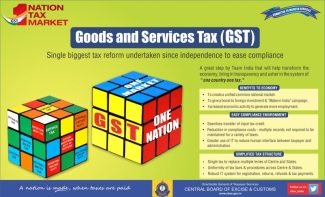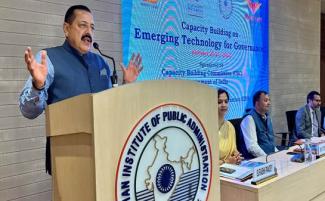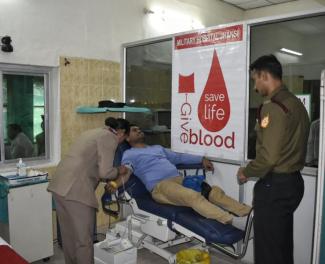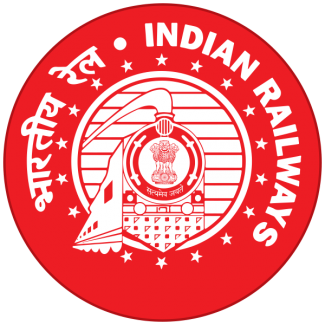
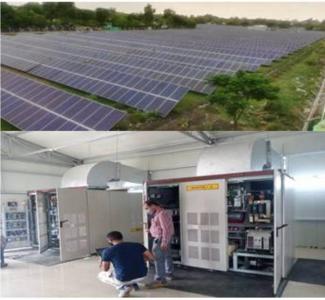
इस समाचार को हिन्दी में पढ़े आगे...
A new dawn ushers on Indian Railways as it endeavors to be self-reliant for its energy needs as directed by the Prime Minister and solarise railway stations by utilizing its vacant lands for Renewable Energy (RE) projects. Railway is committed to utilize solar energy for meeting its traction power requirements and become a complete ‘Green mode of transportation’.
The Ministry of Railways has decided to install solar power plants on its vacant unused lands on mega scale.
The use of solar power will accelerate the Minister of Railways, Shri Piyush Goyal’s mission to achieve conversion of Indian Railways to ‘Net Zero’ Carbon Emission Railway.
Indian Railways present demand would be fulfilled by the solar projects being deployed, making it the first transport organisation to be energy self-sufficient. This would help in making Indian Railways green as well as ‘Atma Nirbhar’.
Indian Railways has acted as a pioneer in green energy procurement. It has started energy procurement from various solar projects like 3 MWp solar plant set up at MCF Raebareilly (UP). About 100 MWp rooftop solar systems have already been commissioned on various stations and buildings of Indian Railways.
Besides, one project of 1.7 MWp at Bina (Madhya Pradesh) which shall be connected directly to Overhead Traction System has already been installed and is presently under extensive testing. It is likely to be commissioned within 15 days. This is the first of its kind project in the world commissioned by Indian Railways in collaboration with Bharat Heavy Electricals Limited (BHEL). It involves adoption of innovative technology for converting Direct Current (DC) to single phase Alternating Current (AC) for feeding directly to Railway’s overhead traction system. The solar power plant has been established near the Bina Traction Sub Station (TSS). It can produce approximately 25 lakh units of energy annually and will save around INR 1.37 Crore for Railway every year.
Indian Railways (IR) and BHEL officials have worked tirelessly to successfully implement this innovative project. The project was undertaken by BHEL under its Corporate Social Responsibility (CSR) scheme. Despite the COVID-19 lockdown and consequent difficulties faced in the availability of material and manpower, IR and BHEL worked together as a team to accomplish this mission in just 8 months from the date of signing of the agreement on 9th October, 2019. The key challenge in this project was the conversion of DC power generated from solar panels to the single phase 25 KV AC power which is used by the Railways traction system. This required the development of high capacity inverters with single phase output which were not readily available in the market. The solar panels generate DC energy which will be converted into AC energy through these unique inverters and stepped up to 25 kV AC -1 ϕ through the transformer to directly feed power to the BINA TSS which will be used for running of electric trains.
In addition to this, two pilot projects for the scheme of land based solar plants for meeting electric traction energy requirements of Indian Railways are under implementation. One of them is a 50 MWp solar power plant on vacant unused land at Bhilai (Chhattisgarh) which shall be connected with Central Transmission Utility (CTU) and is targeted to be commissioned before 31st March, 2021. The 2 MWp solar plant at Diwana (Haryana) which shall be connected to State Transmission utility (STU) is expected to be commissioned before 31st August, 2020.
Railway Energy Management Company Ltd. (REMCL) is working relentlessly to further proliferate the use of solar energy on mega scale. It has already floated tenders for 2 GW of solar projects for Indian Railways to be installed on unutilised railway lands. Indian Railways is also adopting an innovative concept of installation of solar projects along operational railway lines. This will help in preventing encroachment, enhancing the speed and safety of trains and reduction of infrastructure costs due to direct injection of solar power into the traction network. Another tender for installation of 1 GW solar plants along Railway tracks is also planned to be released soon by REMCL.
With these mega initiatives, Indian Railways is leading India’s fight against climate challenge and is taking significant steps towards meeting its ambitious goal of being a net zero carbon emissions organisation and meeting India’s Intended Nationally Determined Contributions (INDC) targets.
‘भारतीय रेलने 2030 तक खुद को ज़ीरो’कार्बन उत्सर्जन वाले जन परिवहन नेटवर्क के रूप में बदलने के लिए मिशन मोड पर निर्णायक कदम उठाए
प्रधानमंत्री नरेन्द्र मोदी के निर्देशानुसार अपनी ऊर्जा जरूरतों के लिए आत्मनिर्भर होने के प्रयास तथा अक्षय ऊर्जा (आरई) परियोजनाओं के लिए अपनी खाली भूमि का उपयोग करने के साथ ही भारतीय रेल एक नए दौर में प्रवेश करने जा रही है। रेलवे अपनी कर्षण शक्ति की आवश्यकताओं को पूरा करने के लिए सौर ऊर्जा का उपयोग करने के साथ ही जन परिवहन का एक हरित माध्यम बनने के लिए प्रतिबद्ध है।
रेल मंत्रालय ने बडे पैमाने पर अपनी खाली भूमि पर सौर ऊर्जा संयंत्र स्थापित करने का निर्णय लिया है।सौर ऊर्जा के उपयोग से रेल मंत्री श्री पीयूष गोयल के उस अभियान को गति मिलेगी जिसके तहत रेलवे को जीरो कार्बन उत्सर्जन वाला जन परिवहन माध्यम बनाने का लक्ष्य रखा गया है।
भारतीय रेलवे की ऊर्जा मांग को सौर परियोजनाओं द्वारा पूरा किया जाएगा, जिससे यह पहला ऐसा जन परिवहन माध्यम बन जाएगा जो पूरी तरह से ऊर्जा के मामले में आत्मनिर्भर होगा। इससे भारतीय रेलवे को परिवहन का हरित माध्यम बनाने के साथ ही पूरी तरह से ‘आत्म निर्भर' भी बनाया जा सकेगा।
भारतीय रेलवे हरित ऊर्जा खरीद के मामले में अग्रणी रहा है। इसने एमसीएफ रायबरेली (यूपी) में स्थापित 3 मेगावाट के सौर संयंत्र जैसे विभिन्न सौर परियोजनाओं से ऊर्जा खरीद शुरू की है। भारतीय रेलवे के विभिन्न स्टेशनों और भवनों पर लगभग 100 मेगावाटवाले सौर पैनल पहले से ही चालू हो चुके हैं।
इसके अलावा, बीना (मध्य प्रदेश) में 1.7 मेगावाट की एक परियोजना जो सीधे ओवरहेड ट्रैक्शन सिस्टम से जुड़ी होगी, पहले ही स्थापित हो चुकी है और वर्तमान में व्यापक परीक्षण के तहत है। इसके 15 दिनों के भीतर चालू होने की संभावना है। भारत हेवी इलेक्ट्रिकल्स लिमिटेड (बीएचईएल) के सहयोग से भारतीय रेलवे द्वारा शुरू की गई दुनिया में यह अपनी तरह की पहली परियोजना है। इसमें रेलवे के ओवरहेड ट्रैक्शन सिस्टम को सीधे फीड करने के लिए डायरेक्ट करंट (डीसी) को सिंगल फेज अल्टरनेटिंग करंट (एसी) में बदलने के लिए अभिनव तकनीक को अपनाया गया है। सौर ऊर्जा संयंत्र को बीना ट्रैक्शन सब स्टेशन (टीएसएस) के पास स्थापित किया गया है। यह सालाना लगभग 25 लाख यूनिट ऊर्जा का उत्पादन कर सकता है और रेलवे के लिए हर साल लगभग 1.37 करोड़ रुपये की बचत करेगा।
भारतीय रेलऔर भेल के अधिकारियों ने इस अभिनव परियोजना को सफलतापूर्वक लागू करने के लिए अथक प्रयास किया है। यह परियोजना भेल द्वारा अपनी कॉर्पोरेट सामाजिक जिम्मेदारी (सीएसआर) योजना के तहत शुरू की गई थी। कोविड-19 लॉकडाउन के दौरान उपकरणों और मानव संसाधन की उपलब्धता में काफी कठिनाई आने के बावजूद भारतीय रेल और बीएचईएल ने मिलकर केवल 8 महीने में इस मिशन को पूरा करने के लिए 9 अक्टूबर, 2019 को एक समझौते पर हस्ताक्षर किए। इस परियोजना की सबसे बडी चुनौती सोलर पैनल से उत्पन्न डीसी पावर को सिंगल फेज 25 केवी एसी पावर में बदलना था जिसका इस्तेमाल रेलवे ट्रैक्शन सिस्टम में किया जाता है। इसके लिए एकल चरण आउटपुट के साथ उच्च क्षमता वाले इनवर्टर के विकास की आवश्यकता थी जो बाजार में आसानी से उपलब्ध नहीं थे।
इसके अतिरिक्त, भारतीय रेलवे की विद्युत कर्षण ऊर्जा आवश्यकताओं को पूरा करने के लिए भूमि आधारित सौर संयंत्रों की योजना के लिए दो पायलट परियोजनाएं कार्यान्वित की जा रही हैं। उनमें से एक भिलाई (छत्तीसगढ़) की खाली पड़ी अनुपयोगी भूमि पर 50 मेगावाट का सौर ऊर्जा संयंत्र है, जो केंद्रीय पारेषण उपयोगिता (सीटीयू) से जुड़ा होगा और 31 मार्च, 2021 से पहले चालू करने का लक्ष्य है। दीवाना में 2 मेगावाट का सौर ऊर्जा संयंत्र हरियाणा) जो राज्य ट्रांसमिशन उपयोगिता (एसटीयू) से जुड़ा होगाके 31 अगस्त, 2020 से पहले चालू होने की उम्मीद है।
रेलवे ऊर्जा प्रबंधन कंपनी लिमिटेड (आईएमसीएल) मेगा पैमाने पर सौर ऊर्जा के उपयोग को आगे बढ़ाने के लिए अथक प्रयास कर रही है। यह पहले से ही भारतीय रेलवे के लिए 2 गीगावॉट की सौर परियोजनाओं के लिए अप्रयुक्त रेलवे भूमि पर स्थापित करने के लिए निविदाएं जारी कर चुका है। भारतीय रेलवे भी परिचालन रेलवे लाइनों के साथ सौर परियोजनाओं की स्थापना की एक अभिनव अवधारणा को अपना रहा है। यह ट्रैक्शन नेटवर्क में सौर ऊर्जा के सीधे इंजेक्शन के कारण अतिक्रमण को रोकने, गाड़ियों की गति और सुरक्षा को बढ़ाने और बुनियादी ढांचे की लागत को कम करने में मदद करेगा। रेलवे पटरियों पर 1गीगावाट केसौर संयंत्रों की स्थापना के लिए एक और निविदा भी आरईएमसीएल द्वारा जल्द ही जारी करने की योजना है।
इन मेगा पहलों के साथ, भारतीय रेलवे जलवायु परिवर्तन की चुनौती के खिलाफ भारत की लड़ाई का नेतृत्व कर रहा है और एक शून्य कार्बन उत्सर्जन परिवहन प्रणाली बनने के अपने महत्वाकांक्षी लक्ष्य को पूरा करने और भारत के राष्ट्रीय स्तर पर निर्धारित योगदान (आईएनडीसी) लक्ष्यों को पूरा करने की दिशा में महत्वपूर्ण कदम उठा रहा है।






